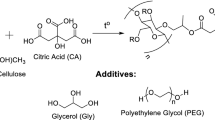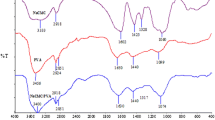Abstract
Carboxymethylcellulose (CMC) was functionalized using methacrylic anhydride (MA) to produce photo-crosslinkable methacrylated carboxymethylcellulose (mCMC). Optimization of the synthesis led to a wide range of mCMC samples with well-controlled degrees of methacrylation up to 76 ± 6%, surpassing the literature data. Aqueous mCMC formulations with different DM and concentrations of mCMC were UV-cured to obtain hydrogels, which were transformed into cryogels after freeze-drying. An innovative 13C CP-MAS solid-state NMR methodology was used to calculate the crosslinked methacrylate density in cryogels and thus in hydrogels. These values (from 4.3 \(\times\) 10–3 to 1.3 \(\times\) 10–2 mmol/cm3) were correlated with both the DM and the mCMC concentration in formulations. These parameters were used to control the material microstructure and rheological properties. As a result, the swelling ratio of hydrated cryogels could be modulated for applications requiring high or low water absorption. Moreover, it was shown that the elastic moduli G’ of the hydrated cryogels were superior to those of the original hydrogels, over the entire frequency range (0.1–10 Hz).






Similar content being viewed by others
Data availability
Additional information regarding this manuscript can be found free of charge in the supporting information.
References
Abbasi N, Hamlet S, Love RM, Nguyen N-T (2020) Porous scaffolds for bone regeneration. J Sci Adv Mater Dev 5(1):1–9. https://doi.org/10.1016/j.jsamd.2020.01.007
Annabi N, Nichol JW, Zhong X, Ji C, Koshy S, Khademhosseini A, Dehghani F (2010) Controlling the Porosity and Microarchitecture of Hydrogels for Tissue Engineering. Tissue Eng Part B Rev 16(4):371–383. https://doi.org/10.1089/ten.teb.2009.0639
Bai X, Gao M, Syed S, Zhuang J, Xiaoyang Xu, Zhang X-Q (2018) Bioactive hydrogels for bone regeneration. Bioact Mater 3(4):401–417. https://doi.org/10.1016/j.bioactmat.2018.05.006
Baier Leach J, Bivens KA, Patrick CW, Schmidt CE (2003) Photocrosslinked hyaluronic acid hydrogels: natural, biodegradable tissue engineering scaffolds. Biotechnol Bioeng 82(5):578–589. https://doi.org/10.1002/bit.10605
Berruyer P, Gericke M, Moutzouri P, Jakobi D, Bardet M, Karlson L, Schantz S, Heinze T, Emsley L (2021) Advanced characterization of regioselectively substituted methylcellulose model compounds by DNP enhanced solid-state NMR spectroscopy. Carbohydr Polym 262(juin):117944. https://doi.org/10.1016/j.carbpol.2021.117944
Capanema NSV, Mansur AAP, de Jesus AC, Carvalho SM, de Oliveira LC, Mansur HS (2018) Superabsorbent crosslinked carboxymethyl cellulose-PEG hydrogels for potential wound dressing applications. Int J Biol Macromol 106(janvier):1218–1234. https://doi.org/10.1016/j.ijbiomac.2017.08.124
Capitani D, Nobile MAD, Mensitieri G, Sannino A, Segre AL (2000) 13 C solid-state NMR determination of cross-linking degree in superabsorbing cellulose-based networks. Macromolecules 33(2):430–437. https://doi.org/10.1021/ma9914117
Cassanelli M, Norton I, Mills T (2018) Role of gellan gum microstructure in freeze drying and rehydration mechanisms. Food Hydrocolloids 75(février):51–61. https://doi.org/10.1016/j.foodhyd.2017.09.013
Chang C, Duan Bo, Cai J, Zhang L (2010) Superabsorbent hydrogels based on cellulose for smart swelling and controllable delivery. Eur Polymer J 46(1):92–100. https://doi.org/10.1016/j.eurpolymj.2009.04.033
Chaudhuri O, Cooper-White J, Janmey PA, Mooney DJ, Shenoy VB (2020) Effects of extracellular matrix viscoelasticity on cellular behaviour. Nature 584(7822):535–546. https://doi.org/10.1038/s41586-020-2612-2
Chen Y-C, Lin R-Z, Qi H, Yang Y, Bae H, Melero-Martin JM, Khademhosseini A (2012) Functional human vascular network generated in photocrosslinkable gelatin methacrylate hydrogels. Adv Func Mater 22(10):2027–2039. https://doi.org/10.1002/adfm.201101662
Cleland RL (1970) Ionic polysaccharides. IV. Free-rotation dimensions for disaccharide polymers. Comparison with experiment for hyaluronic acid. Biopolymers 9(7):811–824. https://doi.org/10.1002/bip.1970.360090707
Darpentigny C, Molina-Boisseau S, Nonglaton G, Bras J, Jean B (2020) Ice-templated freeze-dried cryogels from tunicate cellulose nanocrystals with high specific surface area and anisotropic morphological and mechanical properties. Cellulose 27(1):233–247. https://doi.org/10.1007/s10570-019-02772-8
Dovedytis M, Liu ZJ, Bartlett S (2020) Hyaluronic acid and its biomedical applications: a review. Eng Regen 1:102–113. https://doi.org/10.1016/j.engreg.2020.10.001
Dutta S, Samanta P, Dhara D (2016) Temperature, PH and redox responsive cellulose based hydrogels for protein delivery. Int J Biol Macromol 87(juin):92–100. https://doi.org/10.1016/j.ijbiomac.2016.02.042
Fedorova AF, Rogovin ZA (1963) A Study of the relative reactivity of the hydroxyl groups of cellulose in esterification in an acidic medium. Polym Sci u.s.s.r 4(5):1189–1194. https://doi.org/10.1016/0032-3950(63)90350-2r
Ganji F, Vasheghani-Farahani S, Vasheghani-Farahani E (2010) Theoretical description of hydrogel swelling: a review. Iran Polym J 5(19):375–398
García-Lizarribar A, Fernández-Garibay X, Velasco-Mallorquí F, Castaño AG, Samitier J, Ramon-Azcon J (2018) Composite biomaterials as long-lasting scaffolds for 3D bioprinting of highly aligned muscle tissue. Macromol Biosci 18(10):1800167. https://doi.org/10.1002/mabi.201800167
Gold GT, Varma DM, Taub PJ, Nicoll SB (2015) Development of crosslinked methylcellulose hydrogels for soft tissue augmentation using an ammonium persulfate-ascorbic acid redox system. Carbohyd Polym 134(décembre):497–507. https://doi.org/10.1016/j.carbpol.2015.07.101
Gu L, Zhang Y, Zhang L, Huang Y, Zuo D, Cai Q, Yang X (2020) Comparative study of gelatin cryogels reinforced with hydroxyapatites with different morphologies and interfacial bonding. Biomed Mater 15(3):035012. https://doi.org/10.1088/1748-605X/ab7388
Holtzer AM, Benoit H, Doty P (1954) The Molecular configuration and hydrodynamic behavior of cellulose trinitrate. J Phys Chem 58(8):624–634. https://doi.org/10.1021/j150518a009
Hossen MR, Dadoo N, Holomakoff DG, Co A, Gramlich WM, Mason MD (2018) Wet stable and mechanically robust cellulose nanofibrils (CNF) based hydrogel. Polymer 151(août):231–241. https://doi.org/10.1016/j.polymer.2018.07.016
Hoti G, Caldera F, Cecone C, Pedrazzo AR, Anceschi A, Appleton SL, Monfared YK, Trotta F (2021) Effect of the cross-linking density on the swelling and rheological behavior of ester-bridged β-cyclodextrin nanosponges. Materials 14(3):478. https://doi.org/10.3390/ma14030478
Hove V, Amy H, Wilson BD, Benoit DSW (2013) Microwave-assisted functionalization of poly(ethylene glycol) and on-resin peptides for use in chain polymerizations and hydrogel formation. J vis Exp 80(Octobre):50890. https://doi.org/10.3791/50890
Kanikireddy V, Varaprasad K, Jayaramudu T, Karthikeyan C, Sadiku R (2020) Carboxymethyl cellulose-based materials for infection control and wound healing: a review. Int J Biol Macromol 164(518):963–975. https://doi.org/10.1016/j.ijbiomac.2020.07.160
Kono H, Oshima K, Hashimoto H, Shimizu Y, Tajima K (2016) NMR characterization of sodium carboxymethyl cellulose: substituent distribution and mole fraction of monomers in the polymer chains. Carbohyd Polym 146(août):1–9. https://doi.org/10.1016/j.carbpol.2016.03.021
Lin HA, Gupta MS, Varma DM, Lane Gilchrist M, Nicoll SB (2016) Lower crosslinking density enhances functional nucleus pulposus-like matrix elaboration by human mesenchymal stem cells in carboxymethylcellulose hydrogels: crosslinking density impacts HMSC chondrogenesis. J Biomed Mater Res Part A 104(1):165–177. https://doi.org/10.1002/jbm.a.35552
Luo M, Zhang X, Jun W, Zhao J (2021) Modifications of polysaccharide-based biomaterials under structure-property relationship for biomedical applications. Carbohyd Polym 266(août):118097. https://doi.org/10.1016/j.carbpol.2021.118097
Matricardi P, Pontoriero M, Coviello T, Casadei MA, Alhaique F (2008) In situ cross-linkable novel alginate-dextran methacrylate IPN hydrogels for biomedical applications: mechanical characterization and drug delivery properties. Biomacromol 9(7):2014–2020. https://doi.org/10.1021/bm800252c
Melilli G, Carmagnola I, Tonda-Turo C, Pirri F, Ciardelli G, Sangermano M, Hakkarainen M, Chiappone A (2020) DLP 3D printing meets lignocellulosic biopolymers: carboxymethyl cellulose inks for 3D biocompatible hydrogels. Polymers 12(8):1655. https://doi.org/10.3390/polym12081655
Memic A, Rezaeeyazdi M, Villard P, Rogers ZJ, Abudula T, Colombani T, Bencherif SA (2020) Effect of polymer concentration on autoclaved cryogel properties. Macromol Mater Eng 305(5):1900824. https://doi.org/10.1002/mame.201900824
Muir VG, Burdick JA (2020) Chemically modified biopolymers for the formation of biomedical hydrogels. Chem Rev. https://doi.org/10.1021/acs.chemrev.0c00923
Pacelli S, Di Muzio L, Paolicelli P, Fortunati V, Petralito S, Trilli J, Casadei MA (2021) Dextran-polyethylene glycol cryogels as spongy scaffolds for drug delivery. Int J Biol Macromol 166(janvier):1292–1300. https://doi.org/10.1016/j.ijbiomac.2020.10.273
Picout DR, Ross-Murphy SB (2002) On the chain flexibility of arabinoxylans and other B-(1→4) polysaccharides. Carbohyd Res 337(19):1781–1784
Plieva FM, Karlsson M, Aguilar M-R, Gomez D, Mikhalovsky S, Igor Galaev’ Y (2005) Pore structure in supermacroporous polyacrylamide based cryogels. Soft Matter 1(4):303–309
Poldervaart MT, Goversen B, De Ruijter M, Abbadessa A, Melchels FP, Öner FC, Dhert WJ, Vermonden T, Alblas J (2017) 3D Bioprinting of methacrylated hyaluronic acid (MeHA) hydrogel with intrinsic osteogenicity. PLoS ONE 12(6):e0177628. https://doi.org/10.1371/journal.pone.0177628
Qi H, Liebert T, Meister F, Heinze T (2009) Homogenous carboxymethylation of cellulose in the NaOH/urea aqueous solution. React Funct Polym 69(10):779–784. https://doi.org/10.1016/j.reactfunctpolym.2009.06.007
Qi A, Hoo SP, Friend J, Yeo L, Yue Z, Chan PPY (2014) Hydroxypropyl cellulose methacrylate as a photo-patternable and biodegradable hybrid paper substrate for cell culture and other bioapplications. Adv Healthcare Mater 3(4):543–554. https://doi.org/10.1002/adhm.201300155
Qian H, Wang X, Yuan K, Xie C, Wei Wu, Jiang X, Lijiang Hu (2014) Delivery of doxorubicin in vitro and in vivo using bio-reductive cellulose nanogels. Biomater Sci 2(2):220–232. https://doi.org/10.1039/C3BM60176E
Rahman Md, Saifur Md, Hasan S, Nitai AS, Nam S, Karmakar AK, Shameem Ahsan Md, Shiddiky MJA, Ahmed MB (2021) Recent developments of carboxymethyl cellulose. Polymers 13(8):1345. https://doi.org/10.3390/polym13081345
Razavi M, Qiao Y, Thakor AS (2019) Three-dimensional cryogels for biomedical applications. J Biomed Mater Res, Part A 107(12):2736–2755. https://doi.org/10.1002/jbm.a.36777
Rebelo R, Fernandes M, Fangueiro R (2017) Biopolymers in medical implants: a brief review. Procedia Engineering 200:236–243. https://doi.org/10.1016/j.proeng.2017.07.034
Reeves R, Ribeiro A, Lombardo L, Boyer R, Leach JB (2010) Synthesis and characterization of carboxymethylcellulose-methacrylate hydrogel cell scaffolds. Polymers 2(3):252–264. https://doi.org/10.3390/polym2030252
Reza AT, Nicoll SB (2010) Characterization of novel photocrosslinked carboxymethylcellulose hydrogels for encapsulation of nucleus pulposus cells. Acta Biomater 6(1):179–186. https://doi.org/10.1016/j.actbio.2009.06.004
Sindhu KA, Prasanth R, Thakur VK (2014) Medical applications of cellulose and its derivatives: present and future. In: Thakur VK (ed) Nanocellulose Polymer Nanocomposites. John Wiley & Sons Inc., Hoboken, NJ, USA, pp 437–477
Stalling SS, Akintoye SO, Nicoll SB (2009) Development of photocrosslinked methylcellulose hydrogels for soft tissue reconstruction. Acta Biomater 5(6):1911–1918. https://doi.org/10.1016/j.actbio.2009.02.020
Tomal W, Ortyl J (2020) Water-Soluble Photoinitiators in Biomedical Applications. Polymers 12(5):1073. https://doi.org/10.3390/polym12051073
Uzun M (2018) A review of wound management materials. J Text Eng Fash Technol. https://doi.org/10.15406/jteft.2018.04.00121
van Dijk-Wolthuis WNE, Hoogeboom JAM, van Steenbergen MJ, Tsang SKY, Hennink WE (1997) Degradation and release behavior of dextran-based hydrogels. Macromolecules 30(16):4639–4645. https://doi.org/10.1021/ma9704018
Xia Z, Patchan M, Maranchi J, Elisseeff J, Trexler M (2013) Determination of crosslinking density of hydrogels prepared from microcrystalline cellulose. J Appl Polym Sci 127(6):4537–4541. https://doi.org/10.1002/app.38052
Acknowledgements
The authors acknowledge the NanoBio chemistry platform (ICMG UAR 2607) for granting access to the electron microscopy facilities. The authors also acknowledge Ashland for kindly offering carboxymethylcellulose.
Funding
Financial support from the cross cutting CEA program ‘Matériaux Procédés’ is gratefully acknowledged (CelluloMed project). The authors acknowledge the Agence Nationale de la Recherche for financial support through the LabEx ARCANE program (ANR-11-LABX-0003-01) and the Graduate School of Chemistry, Biology and Health of University Grenoble Alpes CBH-EUR-GS (ANR-17-EURE-0003) and Glyco@Alps. The authors acknowledge the NanoBio-ICMG chemistry platform (FR 2607, Grenoble) for granting access to the electron microscopy facilities.
Author information
Authors and Affiliations
Contributions
All authors contributed to the study conception and design. Material preparation, data collection and analysis were performed by LS, SR, BJ, IT, GN, P-AB and CL-P. The first draft of the manuscript was written by LS and all authors commented on previous versions of the manuscript. All authors read and approved the final manuscript.
Corresponding author
Ethics declarations
Conflict of interest
The authors have no conflicts of interest to declare.
Ethical approval
All authors have read and understood the ‘‘Ethical Responsibilities of Authors’’ in the journal’s ‘‘Submission Guidelines’’, including the passage on screening for plagiarism with computer software.
Consent for publication
All authors have fully read, agreed, and approved the final version of the manuscript which has been submitted for possible publication.
Additional information
Publisher's Note
Springer Nature remains neutral with regard to jurisdictional claims in published maps and institutional affiliations.
Supplementary Information
Below is the link to the electronic supplementary material.
Rights and permissions
Springer Nature or its licensor (e.g. a society or other partner) holds exclusive rights to this article under a publishing agreement with the author(s) or other rightsholder(s); author self-archiving of the accepted manuscript version of this article is solely governed by the terms of such publishing agreement and applicable law.
About this article
Cite this article
Soullard, L., Bayle, PA., Lancelon-Pin, C. et al. Optimization of the methacrylation of carboxymethylcellulose and use for the design of hydrogels and cryogels with controlled structure and properties. Cellulose 30, 6203–6217 (2023). https://doi.org/10.1007/s10570-023-05266-w
Received:
Accepted:
Published:
Issue Date:
DOI: https://doi.org/10.1007/s10570-023-05266-w




